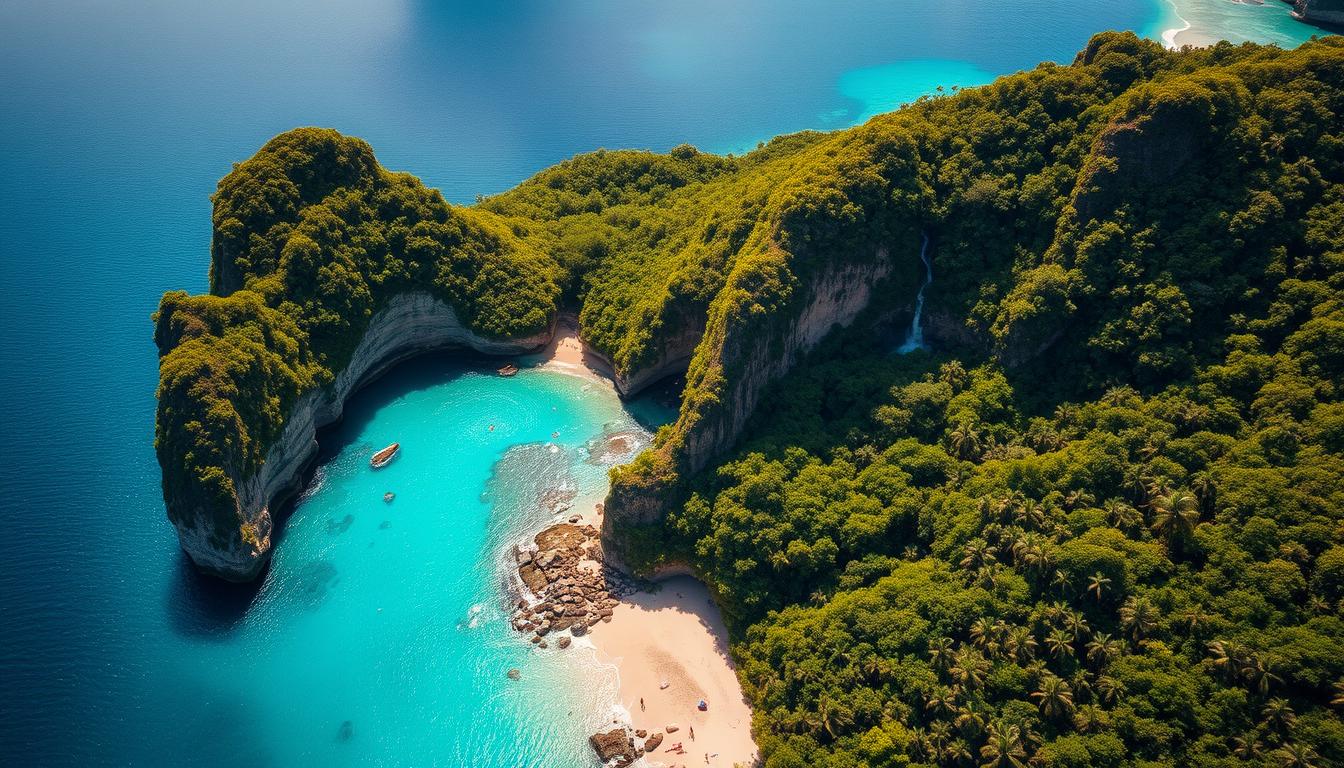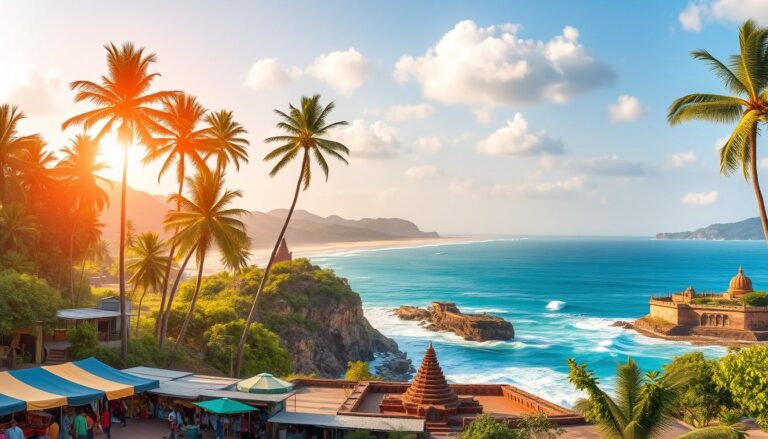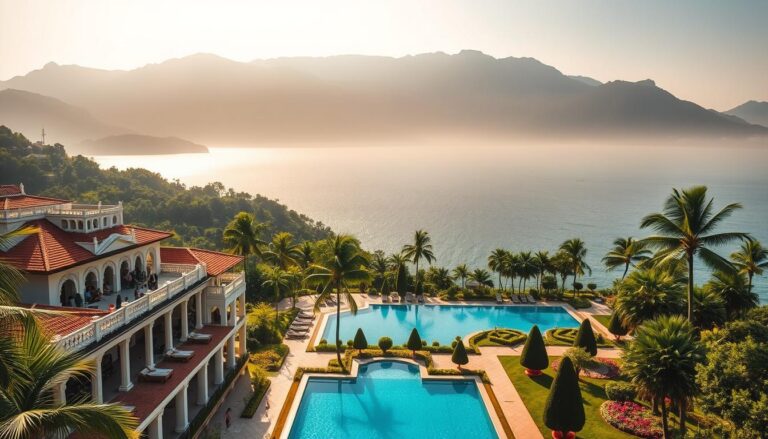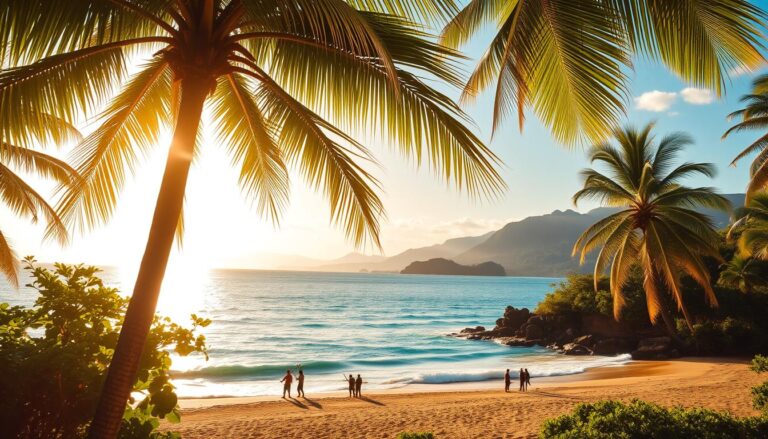Explore Philippines Attractions: Discover Top Spots
Have you ever stood at the edge of a limestone cliff, watching turquoise waves kiss powdery white sand below? Picture that moment—the salt-kissed breeze, the warmth of the sun, and the thrill of stepping into a world where every turn reveals something extraordinary. This isn’t just a vacation; it’s a chance to connect with landscapes and traditions that have shaped lives for generations.

From the emerald rice terraces of Luzon to the coral-rich waters of Palawan, this country is a tapestry of contrasts. You’ll find bustling cities humming with modern energy alongside villages where time moves to the rhythm of ancestral drums. Whether kayaking through hidden lagoons or savoring adobo at a family-run eatery, each experience stitches itself into your story.
This guide isn’t just about checking off iconic spots. It’s about crafting a trip that blends adrenaline-pumping hikes with quiet moments under palm trees. You’ll learn how to navigate markets bursting with handmade crafts, where to find secret beaches near El Nido, and why Vigan’s cobblestone streets whisper tales of Spanish colonial history.
Key Takeaways
- Uncover both popular destinations and lesser-known treasures across 7,000+ islands
- Experience cultural traditions through local festivals and historic architecture
- Get actionable advice for balancing adventure with relaxation
- Learn where to capture stunning photos of natural wonders
- Plan efficiently using tips from seasoned travelers
Introduction to the Philippines
Imagine a place where emerald jungles meet centuries-old stone churches, each telling a story of resilience. This Southeast Asian country spans over 7,000 islands, offering everything from misty mountain peaks to coral-fringed lagoons. Its cultural tapestry blends Spanish colonial influences with indigenous traditions—seen in vibrant festivals and ancestral weaving techniques.
Warm smiles greet you wherever you go, as locals take pride in sharing their way of life. Historic cities like Manila showcase Spanish-era Intramuros alongside glittering business districts. In Vigan, cobblestone streets lead to well-preserved ancestral homes with capiz shell windows—a testament to the architecture shaped by generations.
Your travel choices range from family-run guesthouses in rice terraces to luxury beachfront villas. Dry season (November-April) brings sunny days perfect for island-hopping, while monsoon rains (June-October) paint the landscapes in deeper greens. Each season reveals different things to love about this archipelago.
As you plan your journey, remember that every part of this nation tells a story. From the flavors of street food to the rhythm of traditional dances, you’re not just visiting—you’re becoming part of its living narrative.
Best Beaches and Island Escapes
Picture sinking your toes into sand so fine it feels like powdered sugar, where every step leaves a fleeting imprint. This is the reality of the white-sand beaches that frame countless shorelines here. Azure waves roll gently toward palm-fringed coasts, creating a rhythm that slows your pulse and sharpens your senses.
White-Sand Beaches & Blue Waters
El Nido’s limestone cliffs rise dramatically above lagoons glowing with blue waters so clear you’ll spot parrotfish darting below. Boracay’s 4-kilometer stretch of powdery shore buzzes with energy by day and transforms into a starlit paradise at night. Both destinations offer easy access to snorkeling spots teeming with clownfish and sea turtles.
Island Vibes and Hidden Islands
Venture beyond popular spots to find quiet coves near Puerto Princesa. Fly into its international airport, then hop on a boat to lesser-known islands like Dos Palmas or Pandan. These hidden gems deliver serenity without crowds—perfect for kayaking through mangrove forests or claiming a beach all to yourself.
Choose accommodation ranging from bamboo cottages to resorts with infinity pools overlooking the sea. Whether you’re planning a quick trip or extended stay, the blend of vibrant nature and warm hospitality ensures every moment feels like a discovery.
Cultural Landmarks and Spanish Colonial Heritage
Step into a living museum where cobblestone streets echo with centuries-old stories. The Philippines’ Spanish colonial legacy lives in ancestral mansions, baroque churches, and fortified cities recognized as UNESCO World Heritage sites. These landmarks preserve traditions passed down through generations while showcasing intricate craftsmanship.
UNESCO World Heritage Sites and Ancestral Homes
Four iconic locations hold UNESCO World Heritage status. Vigan’s Calle Crisologo dazzles with 18th-century architecture—cobblestone paths lined with capiz-shell windows and wooden balconies. In Manila, San Agustin Church stands as the oldest stone church in the country, its interiors adorned with trompe-l’oeil paintings.

Historic Cities: Intramuros, Vigan, and More
Intramuros’ stone walls enclose Spanish-era landmarks like Fort Santiago, where José Rizal spent his final days. Beyond Manila, Taal Volcano Island shelters ancestral homes with European furniture and hand-painted tiles. These cities blend history with modern life—watch artisans weave abel cloth in Ilocos or join a kalesa (horse-drawn carriage) ride through Vigan’s plazas.
| Heritage Site | Location | Year Designated | Key Features |
|---|---|---|---|
| Historic City of Vigan | Ilocos Sur | 1999 | Spanish colonial town planning |
| Baroque Churches | Manila, Paoay, Miag-ao | 1993 | Earthquake-resistant architecture |
| San Agustin Church | Intramuros | 1993 | 16th-century frescoes |
Local festivals like Pahiyas bring these sites to life with colorful rice decorations. Guides in period costumes share tales of trade routes and revolution. Each visit deepens your understanding of how Spanish colonial influences shaped the nation’s identity.
Natural Wonders and Scenic Landscapes
What if you could walk through a field of giant molehills that turn golden-brown in summer? The Chocolate Hills of Bohol defy logic—1,268 symmetrical mounds stretching across 20 square miles. During dry months, grass-covered hills transform into earthy cocoa tones, creating a surreal panorama best viewed from Carmen’s observation deck.
Chocolate Hills, Rice Terraces, and Volcanoes
Head north to Luzon’s rice terraces, hand-carved into mountainsides 2,000 years ago. Locals call them “stairs to the sky” for their cloud-piercing elevation. Nearby, Mayon Volcano’s perfect cone dominates Albay province. Its frequent ash plumes remind visitors of nature’s raw power.
Limestone Cliffs and Majestic Mountains
Palawan’s limestone cliffs rise like jagged sentinels above turquoise waters. Kayak through Small Lagoon’s narrow entrance to discover hidden pools. In Mindanao, Mount Apo—the country’s highest mountain—challenges hikers with mossy forests and sulfur vents. Guided treks often include overnight camps near thermal springs.
| Natural Site | Best Time to Visit | Access Tip |
|---|---|---|
| Chocolate Hills | March-May | Rent scooters in Carmen town |
| Banaue Rice Terraces | April-June | Hire local guides for sunrise views |
| Taal Volcano | November-February | Take boat tours from Talisay |
Pack light layers for sudden weather shifts in mountain regions. Most volcanic sites require permits—arrange these through registered tour operators. Whether you’re marveling at ancient landscapes or conquering peaks, these formations reveal Earth’s artistic genius.
Adventures and Outdoor Activities
Feel the rush of salty wind as your bangka boat slices through waves toward uncharted coves. This archipelago serves up endless ways to challenge your limits while connecting with raw nature. Whether you’re gliding through bioluminescent waters or rappelling down jungle waterfalls, every moment fuels your inner explorer.
Island-Hopping and Water Sports
Hop between island gems like Coron’s twin lagoons, where WWII shipwrecks lie beneath turquoise surfaces. Snorkel alongside sea turtles in Moalboal or try freediving in Apo Reef’s protected marine sanctuary. Guided tours often include kayaks for navigating hidden sea caves near El Nido’s limestone cliffs.
Hiking, Diving, and Canyoneering
Strap on harnesses for canyoneering through Kawasan River’s tiered waterfalls—leap from 15-foot ledges into jade pools below. Certified divers explore Tubbataha Reef’s vibrant coral walls, while beginners take introductory tours at Anilao’s house reefs. For land-based thrills, trek Mount Pinatubo’s ash-covered trails to its striking crater lake.
Book through licensed operators who provide safety gear and local guides. Morning tours beat afternoon crowds at popular spots like Sumilon Island. Pack quick-dry clothing and reef-safe sunscreen—many river adventures involve multiple water transitions. From Siargao’s surf breaks to Cebu’s cliff-jumping hotspots, these experiences redefine what an active travel trip can be.
explore philippines attractions – Must-Visit Spots
Imagine finding a beach where your footprints are the first of the day. Beyond postcard-perfect beaches, quieter spots reveal the archipelago’s soul. Local fishermen might point you to Siquijor’s hidden tidal pools or the pink sand coves of Great Santa Cruz Island—places where nature’s beauty feels untouched.

Secrets Only Locals Know
In Camiguin, volcanic hot springs bubble beside abandoned cemeteries submerged in waters. Sleepy towns like Batanes’ Basco offer stone houses clinging to windswept cliffs—a city dweller’s antidote to hustle. Stay in family-run accommodation like Balay Cuyo in Palawan, where breakfast includes stories about sea turtle nesting grounds.
Three things make these spots special: raw authenticity, minimal crowds, and unexpected adventure. Trek to Apuao Grande’s shipwreck via knee-deep tides or kayak through Culion’s mangrove tunnels at dusk. As one traveler noted, “These places don’t just show you scenery—they let you participate in daily life.”
Pack light but smart: rent scooters to reach Caramoan’s secret lagoons and carry cash for village homestays. Remote islands like Jomalig require patience—ferries run twice weekly—but reward with golden sunflower beaches. Whether you seek solitude or cultural immersion, these roads-less-traveled prove the beauty of going where guidebooks don’t.
Culinary Delights and Local Flavors
What if your next bite could transport you through 300 years of history? Filipino cuisine weaves Spanish, Malay, and Chinese influences into every dish. Family recipes pass through generations, turning simple meals into edible heirlooms.
Authentic Filipino Cuisine and Street Food
Start with adobo—tender pork simmered in vinegar and garlic. Each region adds twists: coconut milk in Bicol, pineapple in Luzon. Don’t miss street food like balut (fermented duck egg) or isaw (grilled chicken intestines). Vendors in Cebu City serve crispy lechon with skin so crackling, locals call it “music to the teeth.”
Local Markets and Unique Food Experiences
Dive into Legazpi’s Sunday Market, where farmers lay out purple yams and fresh mangosteens. In Vigan, ancestral homes host cooking classes using clay stoves. Budget travelers flock to carinderias (eateries) for ₱50 ($1) meals, while food halls like Manila’s Mercato offer gourmet twists on classics.
- Try kare-kare (peanut stew) at market stalls in Pampanga
- Sip tsokolate (hot chocolate) in Bacolod’s heritage cafés
- Join a midnight seafood grill at Davao’s Roxas Night Market
As one chef told us, “Our food isn’t just eaten—it’s lived.” From smoky sinigang soups to sweet halo-halo desserts, every flavor reveals layers of culture. Your taste buds will map this place better than any guidebook.
Practical Travel Tips for the U.S. Visitor
Planning your first trip to this Southeast Asian country? Timing and logistics make all the difference. Dry season (November-April) offers sunny days perfect for beach-hopping, while June-October brings lush greenery but occasional downpours. Smart preparation lets you enjoy local life while avoiding common hiccups.
Seasonal Advice and Travel Planning
Book accommodation 3-6 months early for popular islands like Boracay. Coastal resorts fill fast during peak weather windows. In city hubs like Cebu, ride-sharing apps beat hailing taxis during rush hours.
For island-hopping:
- Ferry tickets sell out quickly—reserve online
- Pack light: Small planes limit baggage to 15 lbs
- Carry cash for remote areas with spotty ATMs
Tipping isn’t mandatory, but leave 10% at sit-down restaurants. Locals appreciate polite phrases like “Salamat” (Thank you). Monitor typhoon updates via WeatherPhilippines app if traveling during monsoon edges.
U.S. travelers often overlook domestic flight deals—Cebu Pacific offers $30 hops between islands. Remember: This country spans 7,000+ landmasses. Prioritize 2-3 regions per trip to avoid burnout.
Conclusion
Your journey through this archipelago leaves more than photos—it reshapes how you see the world. From the beauty of hidden lagoons to the grandeur of Spanish-era architecture, every moment connects you to a country rich in contrasts. Vibrant cities pulse with energy, while rural and coastal landscapes whisper tales of ancient traditions.
Pack your curiosity alongside practical tips—early bookings, local guides, and cash for remote places. Whether kayaking past limestone cliffs or savoring family recipes in daily life, these things craft a trip that’s uniquely yours. The blend of adventure and heritage here isn’t just about seeing; it’s about living each discovery.
Let this be your sign to map out routes through emerald rice terraces and coral-filled seas. Dive into city energy or unwind on shores where time slows. As you plan, remember: the true magic lies in unscripted moments—a fisherman’s story shared over sunset, or the thrill of finding your own secret cove. This place doesn’t just offer escapes; it gifts stories that linger long after summer ends.
This country’s treasures await—where will your story begin?





